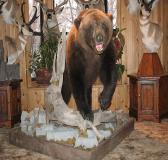
|
Reno Sparks taxidermist field care.
I will try to give you some tips on how to take care of your trophy after you have harvested it. Always remember – Quality In Is Quality Out. You should have your Taxidermist selected before your hunt, so that you can take your trophy to him quickly. You should ask him how he prefers for you to bring it to him. Caping is the process of taking the skin off the carcass. Since skinning the face area is a very delicate process, you should let your taxidermist do this. If your hunt is a warm weather hunt, this may not be possible, and you should get advice from your taxidermist. Always remember to treat your cape or skin like you would your meat. As soon as your trophy is down, bacteria begins to grow. Since heat and moisture create an ideal environment for bacteria, many trophies are ruined within a few hours after being taken. Bacteria causes the hair to slip from the hide. Keep your cape as cool and dry as possible. Caping For A Shoulder Mount When you field dress your trophy, DO NOT CUT THE THROAT and DO NOT CUT THE SKIN PAST THE BREAST BONE OR BRISKET. Start caping the skin off the carcass by cutting a circle around the body of the animal, well behind the front legs and preferably, at the midway point of the rib cage. Just remember, IT IS BETTER TO HAVE EXTRA SKIN, THAN TO CUT YOUR CAPE TOO SHORT. Cut from behind the horns or antlers, straight down the top of the neck, until you intersect the circle you cut around the body. Make sure to cut with your knife under the skin, so that you won’t cut the hair. Cut the front leg skin off at the knees. When opening the skin of the front legs, or forearms, cut from underneath the skin, where the long hair meets the short hair (This is the hair pattern on the back of the front legs). This incision should go parallel to the brisket, and intersect the circular cut you made around the body. (See figures 2A, 2B and 3 Below). Cut the head off the neck about 3 or 4 inches behind the ears. Remember to keep as much blood off the hair as possible. Fold your cape with skin to skin to keep it from drying out. This also helps keep blood off the hair. Keep the cape cool, and get it to your taxidermist as soon as possible. The cape could be double bagged and frozen at this point, if entirely necessary, but most taxidermists would much rather receive it fresh.
Flat Incision
The Flat Incision is the skinning method used for Rugs and most Lifesize Mounts. The areas to cut are shown in Figure 1 Below. After making these incisions, cut the feet free from the carcass, and pull the skin off the carcass, up to the head. The head should then be cut off the neck, just behind the skull.
Important Tips
** Get Blood off the hair as soon as possible, using snow or cold water. ** Use a sharp knife and make straight cuts. ** Keep skins cool at all times – Freeze if you must. ** If freezing a skin, Double Bag and seal tight. Don’t keep skin in freezer very long. ** Always leave more skin on cape than you think you will need. This will give you flexibility, in case you decide to do a pedestal mount, which requires more skin. ** Never salt a skin before it has been fleshed, and the eyes, lips and nose split and the ears turned. ** Never allow direct sunlight on your skin. This will cause spoilage. ** Do not haul open skin in back of your vehicle, uncovered, and exposed to the wind. This will dry the skin out, making it difficult to flesh. ** Do Not Drag your animal. This breaks the hair. Holes can be sewn, but hair cannot be repaired. ** Do not haul your skins in plastic bags. The plastic prevents the skin from being able to get air, and will cause spoilage. Use cloth or burlap bags. ** Never, Never cut the throat of a trophy. This will require you to buy a replacement cape. ** Do Not split the brisket of your cape. |







